Punnett squares examples - Study guides, Class notes & Summaries
Looking for the best study guides, study notes and summaries about Punnett squares examples? On this page you'll find 96 study documents about Punnett squares examples.
Page 2 out of 96 results
Sort by
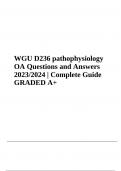
-
WGU D236 pathophysiology Objective Assessment: Exam Questions and Answers Latest 2023/2024 | GRADED A+
- Exam (elaborations) • 71 pages • 2023
- Available in package deal
-
- $24.49
- + learn more
Why would an increased anion gap be observed in diabetic ketoacidosis or lactic acidosis? - ☑️☑️The anion gap is the calculation of unmeasured anions in the blood. Lactic acid and ketones both lead to the production of unmeasured anions, which remove HCO3- (a measured anion) due to buffering of the excess H+ and therefore leads to an increase in the AG. Why is it important to maintain a homeostatic balance of glucose in the blood (ie describe the pathogenesis of diabetes)? - ☑️...

-
WGU D236 Pathophysiology: OA Exam Questions and Answers | Latest Update Graded A+ (2023/2024)
- Exam (elaborations) • 29 pages • 2023
- Available in package deal
-
- $17.49
- + learn more
What is Starling's Law of Capillary forces? How does this explain why a nutritionally deficient child would have edema? Starling’s Law describes how fluids move across the capillary membrane. There are two major opposing forces that act to balance each other, hydrostatic pressure (pushing water out of the capillaries) and osmotic pressure (including oncontic pressure, which pushes fluid into the capillaries). Both electrolytes and proteins (oncontic pressure) in the blood affect osmotic...
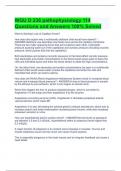
-
WGU D 236 pathophysiology 114 Questions and Answers 100% Solved
- Exam (elaborations) • 32 pages • 2023
-
- $12.49
- + learn more
What is Starling's Law of Capillary forces? How does this explain why a nutritionally deficient child would have edema? - ANSWER-Starling's Law describes how fluids move across the capillary membrane. There are two major opposing forces that act to balance each other, hydrostatic pressure (pushing water out of the capillaries) and osmotic pressure (including oncontic pressure, which pushes fluid into the capillaries). Both electrolytes and proteins (oncontic pressure) in the blood affe...
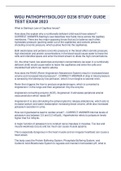
-
WGU PATHOPHYSIOLOGY D236 STUDY GUIDE TEST EXAM 2023
- Exam (elaborations) • 33 pages • 2023
- Available in package deal
-
- $11.99
- + learn more
WGU PATHOPHYSIOLOGY D236 STUDY GUIDE TEST EXAM 2023 What is Starling's Law of Capillary forces? How does this explain why a nutritionally deficient child would have edema? - CORRECT ANSWER-Starling's Law describes how fluids move across the capillary membrane. There are two major opposing forces that act to balance each other, hydrostatic pressure (pushing water out of the capillaries) and osmotic pressure (including oncontic pressure, which pushes fluid into the capillaries). Bo...
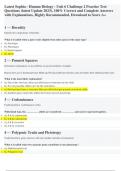
-
Latest Sophia - Human Biology - Unit 6 Challenge 2 Practice Test Questions (latest Update 2023), 100% Correct and Complete Answers with Explanations, Highly Recommended, Download to Score A+
- Exam (elaborations) • 3 pages • 2023
- Available in package deal
-
- $7.99
- + learn more
Latest Sophia - Human Biology - Unit 6 Challenge 2 Practice Test Questions (latest Update 2023), 100% Correct and Complete Answers with Explanations, Highly Recommended, Download to Score A+ 1 — Heredity Identify the components of heredity What is it called when a gene varies slightly from other genes of the same type? a.) Genotype b.) Phenotype c.) Heterozygous d.) Allele 2 — Punnett Squares Determine explanations or possibilities in given hereditary examples B...
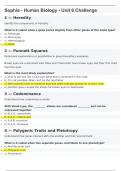
-
Sophia - Human Biology - Unit 6 Challenge
- Exam (elaborations) • 3 pages • 2023
-
- $20.39
- + learn more
1 — Heredity Identify the components of heredity What is it called when a gene varies slightly from other genes of the same type? • a.) Genotype • b.) Phenotype • c.) Heterozygous • d.) Allele 2 — Punnett Squares Determine explanations or possibilities in given hereditary examples Brown eyes are a dominant trait. Mike and Trisha both have brown eyes, but their first child has blue eyes. What is the most likely explanation? • a.) One of the two has a...

-
ATI TEAS 7 QUESTION BANK(QUESTIONS&ANSWERS)2 023 LATEST UPDATE(SCORED OVERALL OF 90% WITH THIS QUESTION BANK)WRITTEN
- Exam (elaborations) • 97 pages • 2023
-
- $17.99
- + learn more
Admin [COMPANY NAME] [Company address] ATI TEAS 7 QUESTION BANK(QUESTIONS&ANSWERS)2 023 LATEST UPDATE(SCORED OVERALL OF 90% WITH THIS QUESTION BANK)WRITTEN ATI TEAS 7 QUESTION BANK(QUESTIONS&ANSWERS)2023 LATEST UPDATE(SCORED OVERALL OF 90% WITH THIS QUESTION BANK) ATI TEAS 7 Exam Test Bank 300 Questions with Answers LATEST UPDATE FOR 2023 1. How are carbohydrates used by the body? Choose ALL answers that apply. • structure • Communication • storage • Recognition 2. W...
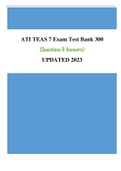
-
ATI TEAS 7 Exam Test Bank 300 (Questions & Answers) UPDATED 2023
- Exam (elaborations) • 68 pages • 2023
-
- $37.99
- + learn more
ATI TEAS 7 Exam Test Bank 300 (Questions & Answers) UPDATED 2023 1. How are carbohydrates used by the body? Choose ALL answers that apply. • structure • Communication • storage • Recognition 2. What type of immunity does a vaccine provide? Choose only ONE best answer. • naturally acquired passive immunity • Artificially acquired passive immunity • Naturally acquired active immunity • Artificially acquired active immunity 3. Which organs and/or glands are superior to ...
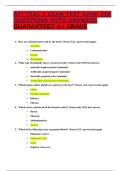
-
ATI TEAS 7 EXAM TEST BANK 300 QUESTIONS WITH ANSWERS GUARANTEED A+ GRADE
- Exam (elaborations) • 104 pages • 2023
-
- $24.99
- + learn more
ATI TEAS 7 EXAM TEST BANK 300 QUESTIONS WITH ANSWERS GUARANTEED A+ GRADE 1. How are carbohydrates used by the body? Choose ALL answers that apply. • structure • Communication • storage • Recognition 2. What type of immunity does a vaccine provide? Choose only ONE best answer. • naturally acquired passive immunity • Artificially acquired passive immunity • Naturally acquired active immunity • Artificially acquired active immunity 3. Which organs and/or glands are supe...
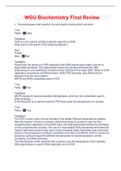
-
WGU Biochemistry Final Review
- Exam (elaborations) • 77 pages • 2022
- Available in package deal
-
- $17.99
- 2x sold
- + learn more
WGU Biochemistry Final Review 1. The polymerase chain reaction is a tool used to study protein structure. True False False Feedback PCR is a tool used to amplify a specific segment of DNA. What color is the primer in the following diagram? Red Purple Blue Red Feedback Recall from the section on DNA replication that DNA polymerase needs a primer to begin DNA synthesis. This requirement means the primers will direct the DNA polymerase to only synthesize complementary stran...

How did he do that? By selling his study resources on Stuvia. Try it yourself! Discover all about earning on Stuvia


